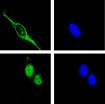(Press-News.org) This news release is available in German.
Scientists of the Max F. Perutz Laboratories of the University of Vienna and the Medical University of Vienna, together with colleagues of the ETH Zurich, have now shown how double stranded RNA, such as viral genetic information, is prevented from entering the nucleus of a cell. During the immune response against viral infection, the protein ADAR1 moves from the cell nucleus into the surrounding cytoplasm. There it modifies viral RNA to inhibit reproduction of the virus. But how is the human genome protected from inadvertent import of viral RNA into the nucleus? The current study of the research teams from Vienna and Zurich, published in PNAS Plus, sheds the first light on this question.
The human immune system: defense against germs
We are constantly exposed to bacteria and viruses. Luckily our body has developed a set of mechanisms – the immune system – to fend off and fight such attacks. Viruses are small particles that cannot survive outside of a host cell. Upon entering the body they release their genetic material into our cells in order to reproduce. This is one of the points where the body's immune system attacks: enzymes chemically modify the viral genetic information in a manner that renders it useless for the production of new virus particles.
ADAR1 – immunological weapon to fight viruses
ADAR1 is one of the enzymes involved in the antiviral immune response. Usually it is located in the nucleus of the cell, but upon infection, ADAR1 relocates to the cytoplasm. It binds and chemically modifies the virus-RNA so that it cannot be used to produce new virus. But how does the cell make sure that ADAR1 doesn't take the bound viral RNA back into the nucleus? After all, the human genome is stored there and needs to be protected. This question was now investigated by the teams of Michael Jantsch from the Max F. Perutz Laboratories (MFPL) of the University of Vienna and Frédéric Allain from the ETH Zurich. As part of the study, funded by a DACH grant for joint projects of German (D), Austrian (A) and Swiss (CH) research groups, Frédéric Allain and his team solved the structure of the ADAR1 RNA-binding domain. This domain was first identified as an important module for RNA binding and cellular localization by the Viennese team around Michael Jantsch. The structure revealed that two modules flanking the RNA-binding region control nuclear transport. Further cell biological analysis by the Viennese team showed that ADAR1 could only relocate into the nucleus when the RNA-binding domain is present to connect the two nuclear transport modules. Michael Jantsch explains: "When we removed the RNA-binding domain, ADAR1 was unable to move into the nucleus. The same was the case when it was bound to viral double-stranded RNA. With the help of the scientists at the ETH we could show how this can be explained structurally."
Which RNAs flip the switch of ADAR1?
The bound RNA actually obstructs the way for ADRA1 to re-enter into the nucleus: the two nuclear transport modules cannot bind their partner that mediates transport across the nuclear envelope because the RNA makes this sterically impossible. "This type of mechanism has never been reported before. You can picture it similarly to driving into a car park. To open the gates you need to get a ticket by pressing a button on the ticket machine. This works fine, unless you transport something really bulky on the roof. In that case the transported goods prevent you from driving close enough to operate the ticket machine", exemplifies Michael Jantsch. Now, he and his team want to identify the RNAs that can actually flip this switch for ADAR1 – so those that can be bound by ADAR1 and prevent its relocation into the nucleus. The researchers are also keen to find out if and which other cellular proteins location are regulated by RNA.
INFORMATION:
Publication in PNAS Plus:
Pierre Barraud, Silpi Banerjee, Weaam I. Mohamed, Michael F. Jantsch and Frédéric H.-T. Allain: A bimodular nuclear localization signal assembled via an extended dsRBD acts as an RNA-sensing signal for Transportin 1. In: PNAS Plus (April 2014).
DOI: http://www.pnas.org/cgi/doi/10.1073/pnas.1323698111
The Max F. Perutz Laboratories (MFPL) are a center established by the University of Vienna and the Medical University of Vienna to provide an environment for excellent, internationally recognized research and education in the field of Molecular Biology. Currently, the MFPL host around 60 independent research groups, involving more than 500 people from 40 nations.
How the body fights against viruses
2014-04-22
ELSE PRESS RELEASES FROM THIS DATE:
What gave us the advantage over extinct types of humans?
2014-04-22
Jerusalem, April 22, 2014 -- In parallel with modern man (Homo sapiens), there were other, extinct types of humans with whom we lived side by side, such as Neanderthals and the recently discovered Denisovans of Siberia. Yet only Homo sapiens survived. What was it in our genetic makeup that gave us the advantage?
The truth is that little is known about our unique genetic makeup as distinguished from our archaic cousins, and how it contributed to the fact that we are the only species among them
to survive. Even less is known about our unique epigenetic makeup, but it ...
Turoctocog alfa in patients with hemophilia A: Added benefit not proven
2014-04-22
Turoctocog alfa (trade name: NovoEight) has been approved since November 2013 for the prevention and treatment of bleeding in patients with haemophilia A. In an early benefit assessment pursuant to the "Act on the Reform of the Market for Medicinal Products" (AMNOG), the German Institute for Quality and Efficiency in Health Care (IQWiG) examined whether this new active ingredient offers an added benefit over the appropriate comparator therapy.
According to the findings, an added benefit of turoctocog alfa is not proven. As no relevant study is available for comparison ...
Life stressors trigger neurological disorders, researchers find
2014-04-22
Washington, DC -- When mothers are exposed to trauma, illness, alcohol or other drug abuse, these stressors may activate a single molecular trigger in brain cells that can go awry and activate conditions such as schizophrenia, post-traumatic stress disorder and some forms of autism.
Until now, it has been unclear how much these stressors have impacted the cells of a developing brain. Past studies have shown that when an expectant mother exposes herself to alcohol or drug abuse or she experiences some trauma or illness, her baby may later develop a psychiatric disorder, ...
Ask yourself: Will you help the environment?
2014-04-22
This news release is available in French. Whether it's recycling, composting or buying environmentally friendly products, guilt can be a strong motivator — not just on Earth Day.
Now, research from Concordia University's John Molson School of Business published in the Journal of Business Ethics, proves that even just asking ourselves, or predicting, whether we will engage in sustainable shopping behaviour can increase the likelihood of following through — especially when there's an audience.
Lead author, marketing professor Onur Bodur explains that, "this is because ...
Brain size matters when it comes to animal self-control
2014-04-22
Chimpanzees may throw tantrums like toddlers, but their total brain size suggests they have more self-control than, say, a gerbil or fox squirrel, according to a new study of 36 species of mammals and birds ranging from orangutans to zebra finches.
Scientists at Duke University, UC Berkeley, Stanford, Yale and more than two-dozen other research institutions collaborated on this first large-scale investigation into the evolution of self-control, defined in the study as the ability to inhibit powerful but ultimately counter-productive behavior. They found that the species ...
Male health linked to testosterone exposure in womb, study finds
2014-04-22
Men's susceptibility to serious health conditions may be influenced by low exposure to testosterone in the womb, new research suggests.
A study has revealed how men's testosterone levels may be determined before they are born.
Understanding why some men have less of the hormone than others is important because testosterone is crucial for life-long health. Low levels of the hormone have been linked to obesity, diabetes and heart disease.
Researchers have shown that the cells responsible for producing testosterone in adults – known as Leydig cells – are derived from ...
FASEB releases updated NIH state factsheets
2014-04-22
The Federation of American Societies for Experimental Biology (FASEB) has released updated factsheets for fiscal year (FY) 2013 highlighting how funding from the National Institutes of Health (NIH) benefits each of the 50 states, DC, and Puerto Rico. "FASEB is pleased to make these factsheets available to help citizens and policymakers understand the significance of NIH to their state," said FASEB President, Margaret K. Offermann, MD, PhD. NIH is the nation's leading source for biomedical research funding, investing $29.2 billion in FY 2013 in medical research, 80 percent ...
Report recommends insurers use prescription monitoring data to reduce opioid abuse, deaths
2014-04-22
WALTHAM, Mass. – The Prescription Drug Monitoring Program Center of Excellence at Brandeis University has issued a ground-breaking report recommending that medical insurers use prescription monitoring data to reduce the overdoses, deaths and health care costs associated with abuse of opioids and other prescription drugs.
"At a time when the misuse and abuse of prescription opioids has reached epidemic levels, it's important that third party payers be able to use states' prescription monitoring data to make sure these drugs are prescribed appropriately," said Peter Kreiner, ...
RNA shows potential as boiling-resistant anionic polymer material for nanoarchitectures
2014-04-22
A team of nanotechnology researchers at the University of Kentucky has discovered new methods to build heat resistant nanostructures and arrays using RNA.
The research, led by Peixuan Guo, professor and William Farish Endowed Chair in Nanobiotechnology at the UK College of Pharmacy and Markey Cancer Center, is reported in an article titled "RNA as a Boiling-Resistant Anionic Polymer Material To Build Robust Structures with Defined Shape and Stoichiometry," coauthored by Emil F. Khisamutdinov and Daniel L. Jasinski.
The article, which will appear in a forthcoming edition ...
EORTC and SIOG update expert opinion on management of elderly patients with NSCLC
2014-04-22
Half of all patients diagnosed with non-small cell lung cancer are 70 years of age or older, yet despite this high percentage, these elderly patients are not well represented in clinical trials. Therefore, the paucity of clinical data has made it difficult to reach evidence based clinical recommendations.
In 2010, the EORTC Cancer in the Elderly Task Force and Lung Cancer Group along with the International Society for Geriatric Oncology (SIOG) wrote an expert opinion on managing treatment for elderly patients with non-small cell lung cancer (NSCLC), and now, in an article ...





